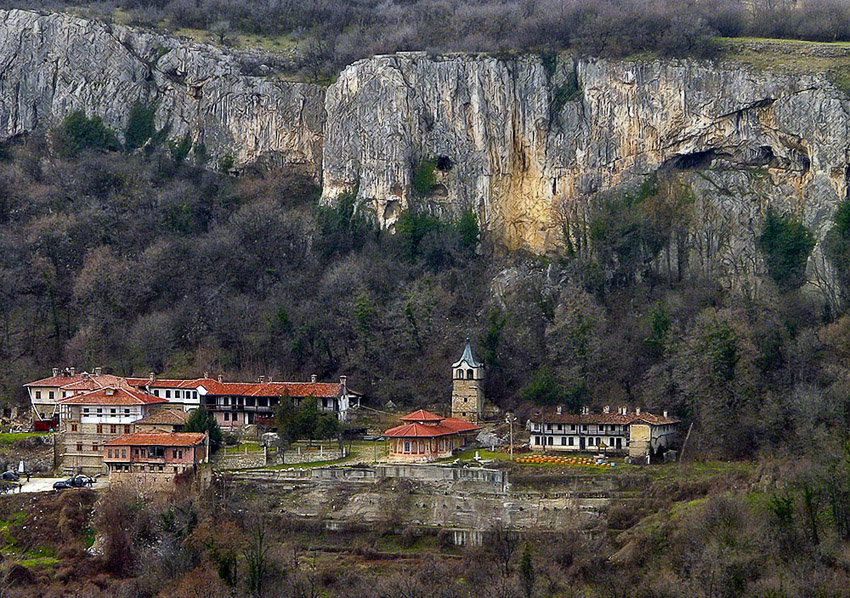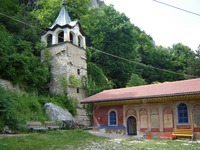 The Transfiguration Monastery is the biggest monastery of those located in the Veliko Turnovo region and the fourth in Bulgaria. It is a precious architectural and artistic monument in Bulgaria. It was established during the time of the Second Bulgarian Empire in 13-14th century. Originally the monastery was a cloister of the Vatopedi monastery on Mount Athos, but it acquired autonomy in 1360. The emergence of the Transfiguration Monastery is related to the charity of Ivan Alexander’s second wife Sarah-Theodora and their son Ivan Shishman since they donated generous funds for its reconstruction and renovation. For that reason the monastery is also called the monastery Sarah’s or Shishman’s monastery. The shrine played an important role for the spiritual life of the Bulgarian capital city in the 14th century.
The Transfiguration Monastery is the biggest monastery of those located in the Veliko Turnovo region and the fourth in Bulgaria. It is a precious architectural and artistic monument in Bulgaria. It was established during the time of the Second Bulgarian Empire in 13-14th century. Originally the monastery was a cloister of the Vatopedi monastery on Mount Athos, but it acquired autonomy in 1360. The emergence of the Transfiguration Monastery is related to the charity of Ivan Alexander’s second wife Sarah-Theodora and their son Ivan Shishman since they donated generous funds for its reconstruction and renovation. For that reason the monastery is also called the monastery Sarah’s or Shishman’s monastery. The shrine played an important role for the spiritual life of the Bulgarian capital city in the 14th century.
In Middle Ages the Transfiguration Monastery was situated about 400-500 m south of its present location. The original place where the monastery stood was abandoned after its destruction during the time when Veliko Turnovo fell under Ottoman yoke in the end of 14th century. After the Ottoman conquest of Bulgaria, the monastery was repeatedly plundered and burned by the Turks and eventually completely destroyed.
 The Transfiguration Monastery was reestablished on its present location by the father Zoticus of the Rila Monastery in 1825. The construction of the main church began in 1834 and was entrusted to Dimitur of Sofia. However, due to his participation of the Velchova Plot in 1834-1835, the master was seized and hanged by the Turks. The noted Bulgarian architect of that time, Kolyo Ficheto, finished the construction of the church. The interior and the outer walls of the temple are decorated with frescoes of high artistic value, created by the eminent Bulgarian icon-painter Zahari Zograf. The whole southeastern wing with the small guest room and the big entrance, the belfry and the small shrine “The Annunciation” were all built until 1863.The Transfiguration Monastery was reestablished on its present location by the father Zoticus of the Rila Monastery in 1825. The construction of the main church began in 1834 and was entrusted to Dimitur of Sofia. However, due to his participation of the Velchova Plot in 1834-1835, the master was seized and hanged by the Turks. The noted Bulgarian architect of that time, Kolyo Ficheto, finished the construction of the church. The interior and the outer walls of the temple are decorated with frescoes of high artistic value, created by the eminent Bulgarian icon-painter Zahari Zograf. The whole southeastern wing with the small guest room and the big entrance, the belfry and the small shrine “The Annunciation” were all built until 1863.During the time of the father Zoicus, the Transfiguration Monastery has gradually turned into one of the main cultural and revolutionary centres in the Veliko Turnovo region. The Apostle of Freedom, Vassil Levski, found his shelter several times in the monastery. The Transfiguration cloister played an important role in the struggles of Bulgarian nation for religious and national independence. Similarly to other monasteries dated back to that time, the monastery was turned into a hospital during the time of the Russian-Turkish Liberation war. As a gesture of gratitude, after the Liberation Russian soldiers made gifts to the monastery, the bells, chandeliers and liturgy books for the church.
The Transfiguration Monastery was reestablished on its present location by the father Zoticus of the Rila Monastery in 1825. The construction of the main church began in 1834 and was entrusted to Dimitur of Sofia. However, due to his participation of the Velchova Plot in 1834-1835, the master was seized and hanged by the Turks. The noted Bulgarian architect of that time, Kolyo Ficheto, finished the construction of the church. The interior and the outer walls of the temple are decorated with frescoes of high artistic value, created by the eminent Bulgarian icon-painter Zahari Zograf. The whole southeastern wing with the small guest room and the big entrance, the belfry and the small shrine “The Annunciation” were all built until 1863.The Transfiguration Monastery was reestablished on its present location by the father Zoticus of the Rila Monastery in 1825. The construction of the main church began in 1834 and was entrusted to Dimitur of Sofia. However, due to his participation of the Velchova Plot in 1834-1835, the master was seized and hanged by the Turks. The noted Bulgarian architect of that time, Kolyo Ficheto, finished the construction of the church. The interior and the outer walls of the temple are decorated with frescoes of high artistic value, created by the eminent Bulgarian icon-painter Zahari Zograf. The whole southeastern wing with the small guest room and the big entrance, the belfry and the small shrine “The Annunciation” were all built until 1863.During the time of the father Zoicus, the Transfiguration Monastery has gradually turned into one of the main cultural and revolutionary centres in the Veliko Turnovo region. The Apostle of Freedom, Vassil Levski, found his shelter several times in the monastery. The Transfiguration cloister played an important role in the struggles of Bulgarian nation for religious and national independence. Similarly to other monasteries dated back to that time, the monastery was turned into a hospital during the time of the Russian-Turkish Liberation war. As a gesture of gratitude, after the Liberation Russian soldiers made gifts to the monastery, the bells, chandeliers and liturgy books for the church.
Some of the monks’ cells in the Transfiguration Monastery were destroyed in 1991 after the demolition of the rocks above the monastery.
 The Transfiguration Monastery is the biggest monastery of those located in the Veliko Turnovo region and the fourth in Bulgaria. It is a precious architectural and artistic monument in Bulgaria. It was established during the time of the Second Bulgarian Empire in 13-14th century. Originally the monastery was a cloister of the Vatopedi monastery on Mount Athos, but it acquired autonomy in 1360. The emergence of the Transfiguration Monastery is related to the charity of Ivan Alexander’s second wife Sarah-Theodora and their son Ivan Shishman since they donated generous funds for its reconstruction and renovation. For that reason the monastery is also called the monastery Sarah’s or Shishman’s monastery. The shrine played an important role for the spiritual life of the Bulgarian capital city in the 14th century.
The Transfiguration Monastery is the biggest monastery of those located in the Veliko Turnovo region and the fourth in Bulgaria. It is a precious architectural and artistic monument in Bulgaria. It was established during the time of the Second Bulgarian Empire in 13-14th century. Originally the monastery was a cloister of the Vatopedi monastery on Mount Athos, but it acquired autonomy in 1360. The emergence of the Transfiguration Monastery is related to the charity of Ivan Alexander’s second wife Sarah-Theodora and their son Ivan Shishman since they donated generous funds for its reconstruction and renovation. For that reason the monastery is also called the monastery Sarah’s or Shishman’s monastery. The shrine played an important role for the spiritual life of the Bulgarian capital city in the 14th century. The Transfiguration Monastery was reestablished on its present location by the father Zoticus of the Rila Monastery in 1825. The construction of the main church began in 1834 and was entrusted to Dimitur of Sofia. However, due to his participation of the Velchova Plot in 1834-1835, the master was seized and hanged by the Turks. The noted Bulgarian architect of that time, Kolyo Ficheto, finished the construction of the church. The interior and the outer walls of the temple are decorated with frescoes of high artistic value, created by the eminent Bulgarian icon-painter Zahari Zograf. The whole southeastern wing with the small guest room and the big entrance, the belfry and the small shrine “The Annunciation” were all built until 1863.The Transfiguration Monastery was reestablished on its present location by the father Zoticus of the Rila Monastery in 1825. The construction of the main church began in 1834 and was entrusted to Dimitur of Sofia. However, due to his participation of the Velchova Plot in 1834-1835, the master was seized and hanged by the Turks. The noted Bulgarian architect of that time, Kolyo Ficheto, finished the construction of the church. The interior and the outer walls of the temple are decorated with frescoes of high artistic value, created by the eminent Bulgarian icon-painter Zahari Zograf. The whole southeastern wing with the small guest room and the big entrance, the belfry and the small shrine “The Annunciation” were all built until 1863.During the time of the father Zoicus, the Transfiguration Monastery has gradually turned into one of the main cultural and revolutionary centres in the Veliko Turnovo region. The Apostle of Freedom, Vassil Levski, found his shelter several times in the monastery. The Transfiguration cloister played an important role in the struggles of Bulgarian nation for religious and national independence. Similarly to other monasteries dated back to that time, the monastery was turned into a hospital during the time of the Russian-Turkish Liberation war. As a gesture of gratitude, after the Liberation Russian soldiers made gifts to the monastery, the bells, chandeliers and liturgy books for the church.
The Transfiguration Monastery was reestablished on its present location by the father Zoticus of the Rila Monastery in 1825. The construction of the main church began in 1834 and was entrusted to Dimitur of Sofia. However, due to his participation of the Velchova Plot in 1834-1835, the master was seized and hanged by the Turks. The noted Bulgarian architect of that time, Kolyo Ficheto, finished the construction of the church. The interior and the outer walls of the temple are decorated with frescoes of high artistic value, created by the eminent Bulgarian icon-painter Zahari Zograf. The whole southeastern wing with the small guest room and the big entrance, the belfry and the small shrine “The Annunciation” were all built until 1863.The Transfiguration Monastery was reestablished on its present location by the father Zoticus of the Rila Monastery in 1825. The construction of the main church began in 1834 and was entrusted to Dimitur of Sofia. However, due to his participation of the Velchova Plot in 1834-1835, the master was seized and hanged by the Turks. The noted Bulgarian architect of that time, Kolyo Ficheto, finished the construction of the church. The interior and the outer walls of the temple are decorated with frescoes of high artistic value, created by the eminent Bulgarian icon-painter Zahari Zograf. The whole southeastern wing with the small guest room and the big entrance, the belfry and the small shrine “The Annunciation” were all built until 1863.During the time of the father Zoicus, the Transfiguration Monastery has gradually turned into one of the main cultural and revolutionary centres in the Veliko Turnovo region. The Apostle of Freedom, Vassil Levski, found his shelter several times in the monastery. The Transfiguration cloister played an important role in the struggles of Bulgarian nation for religious and national independence. Similarly to other monasteries dated back to that time, the monastery was turned into a hospital during the time of the Russian-Turkish Liberation war. As a gesture of gratitude, after the Liberation Russian soldiers made gifts to the monastery, the bells, chandeliers and liturgy books for the church.